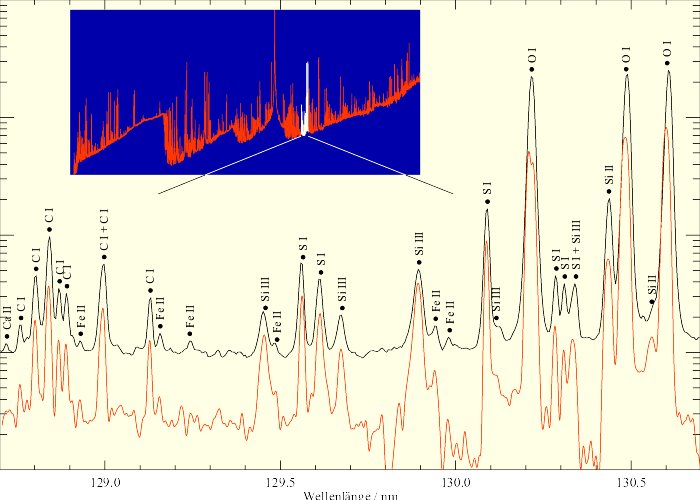UV/Vis+ Photochemistry Database
The SUMER Reference Spectrum (Data
and Information provided by Werner
Curdt, Max Planck Institute for Solar System Research, (C) MPS)
SUMER is a UV telescope
and spectrometer designed for high-resolution observations of the Solar
atmosphere in the extreme ultraviolet wavelength range from 50 to 160
nm. The instrument was built with international cooperation at the Max-Planck-Institut für Solar System Research
(former MPAE), Lindau, Germany, from 1987 to 1995. It is part
of the payload on-board the ESA/NASA spacecraft SOHO, which was launched on 02
Dec 1995. Since the beginning of 1996, SUMER works successfully at a distance
approximately 1.5 million kilometers from Earth towards the Sun and delivers
spectroscopic information of the Sun's EUV emission which is analysed and
archived at various institutions. Free acces to the MPS
archive has been granted to registered users.

The solar emission in the SUMER spectral range is composed of more than 1000 emission lines, recombination continua and, at longer wavelength, of black-body emission. The SUMER reference spectrum presented here combines better spectral and spatial resolutions than any previous observation in the same wavelength range, as well as the most up-to-date line identification. The disk atlas (Astron. Astrophys. 375, 591; 2001) contains spectra of the average quiet Sun, a coronal hole, and a sunspot on disk. The coronal atlas (Astron. Astropys. 427, 1045; 2004) contains off-disk spectra of the corona above a coronal hole, a quiet region, the active corona, and a flare.
SUMER data and information
-
Update from A&A "The SUMER Spectral Atlas of Solar-Disk Features" (pdf, 2 MB)
-
Spectral Atlas Data (IDL XDR Format, 855 KB)
-
Update from "The SUMER Spectral Atlas of Solar Coronal Features" (pdf, 1.7 MB)
-
Coronal Atlas Data (IDL XDR Format, 980 KB)
